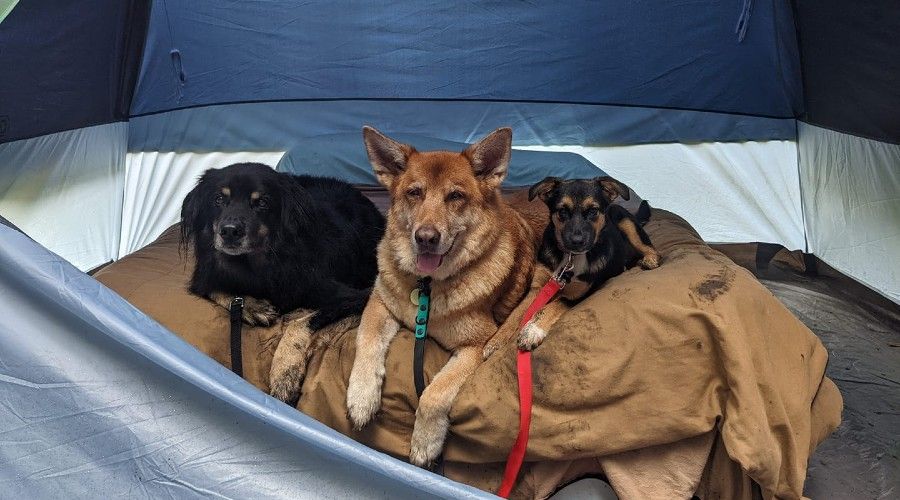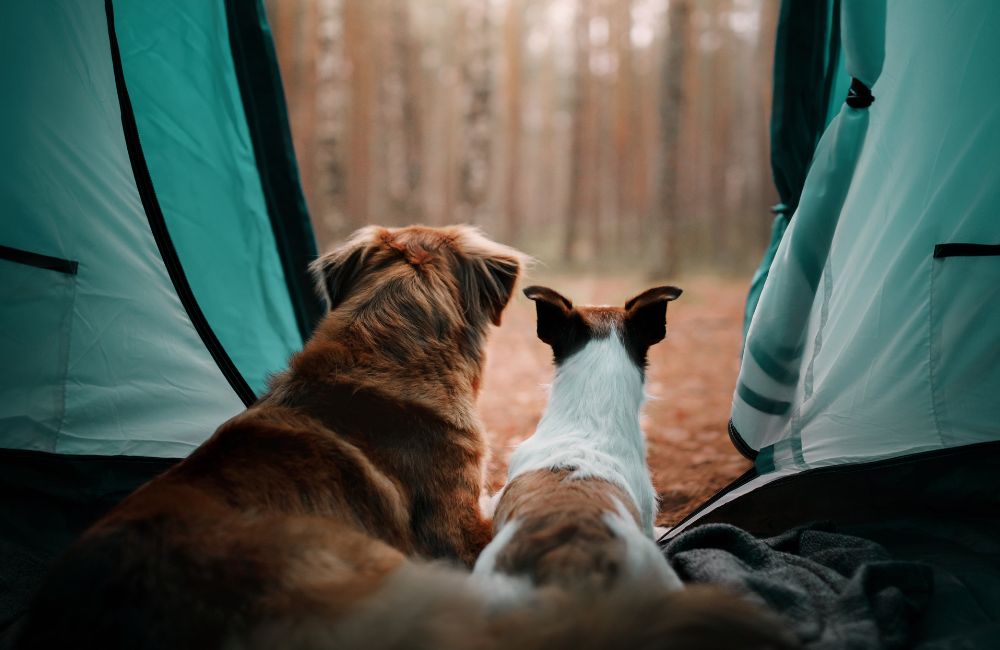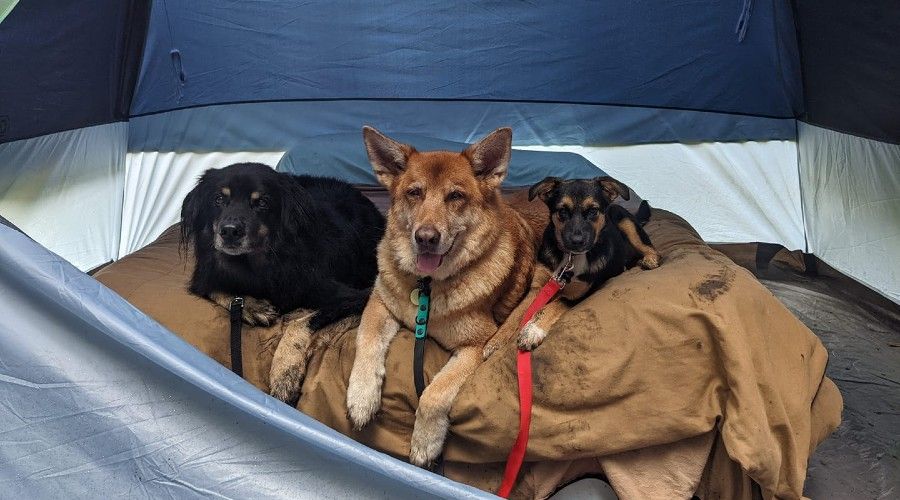Every year, countless adventurous dog owners pack their bags and head into the wilderness with their canine companions. However, not all are prepared for the challenges of keeping their dogs safe and controlled in the wild. Ensuring your pup knows essential obedience commands can be the difference between a fun trip and a hazardous one.
Historically, many dogs were bred for activities that align closely with camping, such as hunting and herding. This creates a unique dynamic where obedience commands are crucial for tapping into their instincts safely. A well-trained dog can confidently follow directions like “come,” “stay,” and “leave it,” which are vital for avoiding dangers and navigating various outdoor environments.

Source: backyardbossimages.com
Camping with Dogs: Obedience Commands Every Pup Should Know in the Wild
When you’re camping with dogs, it’s critical they respond to certain commands. The “come” command is essential. Imagine your dog chasing a squirrel towards a busy trail; a quick response to “come” can prevent accidents. Practicing this command in a controlled environment builds trust and safety. It’s especially important in places like Spokane or Coeur d’Alene ID where wildlife encounters are common.
Another vital command is “stay.” This keeps your dog in one place, which is crucial at a campsite. You don’t want your dog wandering into other campers’ areas or wildlife zones. Use rewards to teach this command effectively. Reinforcing this during your camping trips ensures your dog’s safety and your peace of mind.
The “leave it” command is also important in the wild. It helps prevent your dog from eating harmful plants or objects. Whether in Post Falls, Idaho, or another camping site, there are many potential hazards. Training your dog to “leave it” can save them from getting sick. This command also works well with food at campsites, avoiding messy situations.
Remember to reinforce these commands in real settings. Practice in parks or hiking trails near your home. Consistent reinforcement helps your dog adapt to different environments. Camping in places near wildlife will test their obedience. This is where services like Off Leash K9 Training Spokane can help.
Essential Commands to Teach Before Your Trip
Before heading out on an adventure, teaching your dog the “sit” command is crucial. It helps your pup pause and focus on you. This becomes handy when you’re setting up a tent or preparing meals. A quick “sit” keeps your curious dog from getting into dangerous situations. Reinforce this command with treats for effective learning.
The “down” command is another important skill. It encourages your dog to lie down and relax. This is perfect for quiet moments around the campfire. If your dog gets too excited, a “down” can bring calmness. This ensures both you and your dog enjoy peaceful evenings in the wild.
Using the “heel” command keeps your dog safe during hikes. It ensures they walk next to you, rather than pulling ahead. This is important when navigating rocky trails, common around Post Falls, Idaho. Practicing “heel” in familiar areas makes it easier in the wild. Consistency with this command provides a safer hiking experience.
Lastly, “off” teaches your dog to avoid unwanted jumping. When meeting new people or animals, “off” keeps your dog friendly and polite. This is especially important in social camping areas like Coeur d’Alene ID. Practicing “off” at home prepares your dog for trips. This enhances your dog’s interactions outdoors.
The Importance of ‘Come’ Command in the Wilderness
The “come” command is one of the most vital instructions your dog should know when in the wilderness. This command can help keep your dog from straying too far or running into danger. Whether you’re hiking in the forests around Spokane or enjoying the lakes near Coeur d’Alene, ID, a reliable recall command ensures your dog’s safety. Practicing “come” in different environments makes it more dependable. Consistency and positive reinforcement are key.
Imagine your dog spots something interesting and starts to chase it. A prompt response to “come” can prevent a potentially dangerous situation. Wildlife encounters can be unpredictable. Inserting the “come” command into daily routines helps reinforce its importance. This not only boosts your dog’s obedience but also builds trust between you.
When your dog reliably responds to “come,” it gives you peace of mind. You can enjoy your trip without constantly worrying about your dog’s whereabouts. This is especially important in busy or unfamiliar camping sites. Training sessions can be held in various local parks to improve response times. Over time, this command becomes second nature to your dog.
Using treats or favorite toys as rewards can make learning “come” fun for your dog. Practice in different settings to generalize the command. Even around Post Falls, Idaho, such training ensures your dog listens no matter the distractions. The goal is to have a well-behaved dog that comes when called, ensuring a safe and enjoyable camping experience.
Using ‘Stay’ to Maintain Safety at the Campsite
The “stay” command is invaluable when camping with your dog. It keeps your dog in one place, preventing them from wandering off. Imagine you’ve just set up camp near a scenic trail in Post Falls, Idaho. Having your dog stay put allows you to organize without worrying about them getting lost. This command can be life-saving.
By practicing “stay,” your dog learns to remain calm even in exciting situations. This is essential when other campers or wildlife are nearby. It helps avoid unwanted interactions. Keeping your dog still while you cook or handle gear prevents accidents. Reinforce this behavior with treats or praise.
Training your dog to stay during hikes is equally important. It offers you control in situations where your dog’s curiosity might lead them astray. For example, if you encounter other hikers on narrow paths around Spokane, “stay” helps manage the situation. It also allows you to rest without the risk of your dog wandering. Consistent practice in familiar areas builds their confidence.
Using “stay” also enhances your dog’s obedience in various environments. This command is useful in urban spaces and in nature. Practicing in different settings ensures your dog responds reliably. In Coeur d’Alene, ID, diverse trails and parks provide great training spots. This prepares your dog for any scenario while camping.
Structured practice sessions can reinforce the “stay” command. Short, frequent training sessions work best. Gradually increase the distance and duration of the stay to build reliability. This way, your dog remains calm and obedient, ensuring a safe and enjoyable camping trip.
Incorporating “stay” in your dog’s training routine helps keep them safe and controlled. It reduces risks and enhances the camping experience for everyone. Investing time in teaching this command pays off in peace of mind. A trained dog is a happy and safer camping companion.
Teaching ‘Leave It’ to Avoid Dangerous Wildlife Interactions
The “leave it” command is crucial when camping with dogs in the wild. It helps prevent your dog from engaging with potentially dangerous wildlife. Whether in Spokane or Coeur d’Alene, ID, encounters with animals can be unpredictable. Teaching your dog to “leave it” can save them from injuries or illness. This command is a must-have for any outdoor adventure.
Training “leave it” starts with simple exercises at home. Begin by placing a treat on the ground and covering it with your hand. When your dog shows interest, say “leave it” and reward them when they look away. Gradual practice builds your dog’s understanding. Eventually, they learn to ignore various distractions on command.
Applying “leave it” in outdoor settings increases its effectiveness. Practice during walks in local parks or while hiking near Post Falls, Idaho. This helps your dog generalize the command in different environments. Consistency is important. Reinforcing this command ensures your dog responds reliably.
Using “leave it” also prevents your dog from eating harmful plants or objects. Many campsite areas have flora that can be toxic to dogs. Teaching them to avoid these items keeps them safe. This command can be a real lifesaver. Regular practice is key to success.
Interactive games can make learning “leave it” fun for your dog. Use toys or other objects they like during training sessions. Mixing up the rewards keeps them engaged. Gradual increments of difficulty help solidify the command. This makes it easier to handle unexpected encounters in the wild.
Preparing your dog with the “leave it” command provides peace of mind during camping trips. It minimizes the risk of dangerous wildlife interactions. Investing time in this training is essential for a safe experience. A well-trained dog enhances the joy of camping and ensures everyone stays safe.
How to Reinforce Training in Natural Settings
Training your dog in natural settings can boost their overall obedience. Outdoor environments present unique distractions that help solidify commands. Practicing commands in parks or on hiking trails near Spokane is a good start. These places have more stimuli than your backyard. The varied scenery reinforces your dog’s skills under different conditions.
In natural settings, use rewards to maintain your dog’s focus. Treats or favorite toys work well to grab their attention. Be consistent with praise when they obey commands like “sit” or “stay.” This positive reinforcement creates associations they remember. Gradual exposure to new environments keeps them engaged and improves recall.
To combat unpredictable nature elements, try brief training sessions. Short, frequent practices prevent your dog from getting bored. Keep them motivated with varied drills. Rotate through commands such as “come,” “stay,” and “leave it” during these sessions. This strategy strengthens your dog’s response time.
Maintaining training consistency is key. Use everyday opportunities to practice commands naturally. For example, calling “come” at the park in Coeur d’Alene, ID, or telling them to “stay” while preparing food outdoors. Real-life practice hones their skills. It makes obedience second nature to your dog.
To enhance your dog’s confidence, introduce mild distractions. In an area like Post Falls, Idaho, where wildlife encounters are common, practice with controlled stimuli. This prepares them for the unexpected. Gradually increasing distraction levels tests their focus. It encourages your dog to remain steady even in high-energy situations.

Source: adamspetcare.com
Frequently Asked Questions
Exploring the wilderness with your dog is an exciting adventure. To make sure it goes smoothly, here are some frequently asked questions and their answers about camping with dogs.
1. What should I pack for my dog when camping?
When camping with your dog, pack essentials like food, water, a bowl, leash, and collar. Bring a first aid kit, poop bags, and a blanket for comfort. Don’t forget their favorite toy or chew item to keep them entertained. These items ensure your dog’s basic needs and safety are covered.
Add a light for their collar for nighttime visibility. Carry identification tags with up-to-date information in case they get lost. Your dog’s vaccination records are also good to have on hand. Prepare for various weather conditions with a dog sweater or raincoat. This plan keeps your trip stress-free.
2. How can I keep my dog calm at the campsite?
To keep your dog calm at the campsite, ensure they get plenty of exercise during the day. A tired dog is usually a calm dog. Create a space with familiar items like their bed or blanket. This helps in making them feel secure and relaxed while enjoying the outdoors.
Practice basic commands like “sit” and “stay” to maintain control. Providing a chew toy or interactive toy can keep them occupied. Establish a routine similar to home to reduce anxiety. This consistency helps your dog adjust to the new environment more comfortably.
3. What are some tips to avoid wildlife encounters?
Avoiding wildlife encounters starts with keeping your dog on a leash at all times. This limits their ability to chase or provoke wildlife. Stick to designated trails and campsites where animal encounters are less likely. Clean up food scraps and store food properly to avoid attracting animals.
Train your dog with commands like “leave it” to deter them from approaching wildlife. Make noise while hiking to alert animals of your presence. If you spot wildlife, stay calm and slowly move away. These measures help in reducing risky interactions with wild animals.
4. How do I handle emergencies with my dog while camping?
Handling emergencies with your dog involves having a first aid kit specifically for pets. Include items like bandages, antiseptic wipes, and tweezers. Know the location of the nearest veterinary clinic or emergency vet. Keep important contact numbers handy for any unforeseen situations.
Regularly check your dog for ticks or injuries. Familiarize yourself with basic first aid procedures for pets. Practice these skills so you’re prepared. Having a plan and necessary supplies ensures you’re ready to handle emergencies efficiently.
5. Can I train my dog while camping?
Yes, camping is a great opportunity to reinforce training commands. Use the distractions in the wild to practice commands like “come,” “stay,” and “leave it.” The outdoor environment offers varied challenges that can enhance your dog’s obedience. Short, regular sessions help maintain their focus.
Reward your dog with treats and praise for good behavior. Training in different settings helps your dog generalize commands. This makes them more reliable in various situations. Camping trips thus become a useful and enjoyable training experience for both you and your dog.
Conclusion
Camping with dogs can be an incredibly rewarding experience, blending the joys of nature with the companionship of your furry friend. By teaching essential obedience commands like “come,” “stay,” and “leave it,” you create a safer environment for your dog. These commands are crucial for avoiding potential dangers and ensuring your camping trip is enjoyable.
Remember, consistency and positive reinforcement are key to effective training. Practicing in various settings prepares your dog for the unpredictability of the wild. With proper preparation and training, your adventure with your dog will be both safe and memorable, enhancing the bond between you and your canine companion.
Off Leash K9 Training Spokane / Coeur d’Alene is the Premier Dog Trainers in Eastern Washington and North Idaho Area.
Their website: http://www.dogtrainersspokanewa.com
Their course offerings: https://dogtrainersspokanewa.com/prices/
Phone: 509-481-9223
Contact Off Leash K9 Training Spokane, Washington to learn more about the Training Programs they offer to help you and your dog.
Not in Spokane? To Find an Off Leash K9 Training location near you look here.


